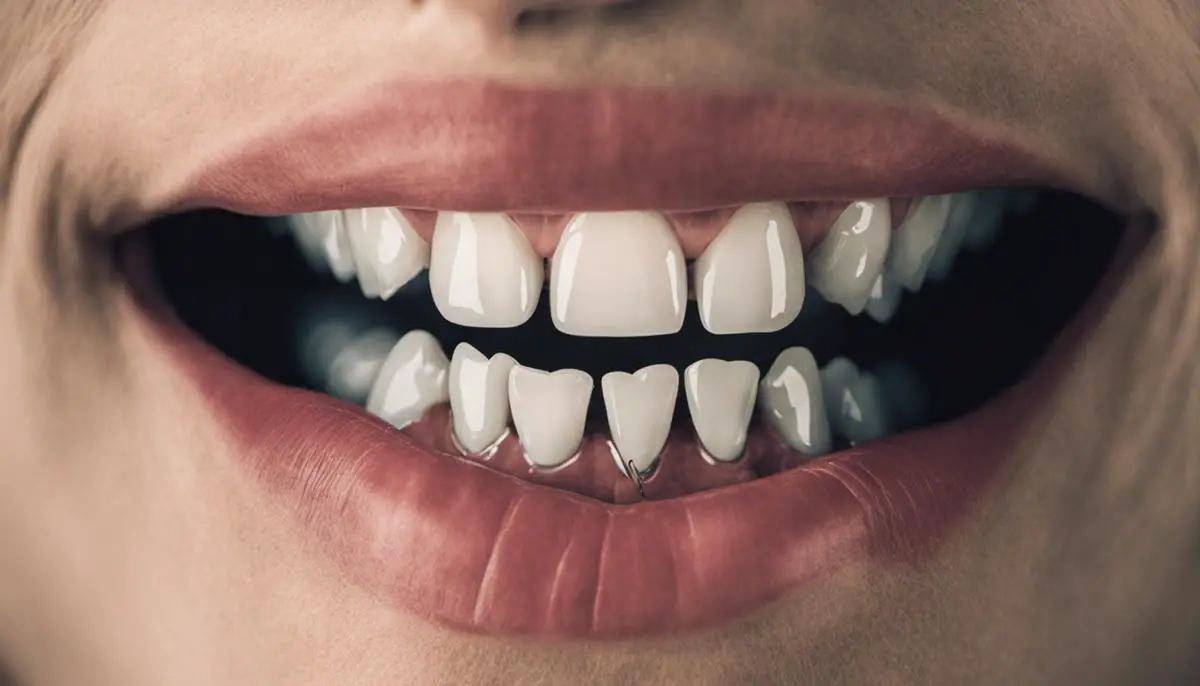The human subconscious is a labyrinth of enigmatic symbols and encoded meanings, with dreams serving as its esoteric language. This conception has been echoed by luminary psychologists such as Sigmund Freud and Carl Jung, who postulated that dreaming of teeth falling out could possess profound psychological implications. This narrative endeavors to delineate the multifaceted interpretations of this recurring motif, with a deep dive into psychoanalytical theories, global cultural interpretations, and neurobiological insights. Moreover, this discourse also aims to investigate the practical implications of such dreams, underlining potential coping strategies and extraction of personal significance.
Psychoanalytical Interpretation of Dreams
Psychoanalytic Perspectives on Dreams and Symbolism: The Case of Falling Teeth
Psychoanalysis, since Sigmund Freud’s iconic revelations, has dramatically influenced our understanding of dreams and their symbolism. One dream that has persistently echoed in the chambers of psychoanalytic theory is the unsettling yet surprisingly common experience of teeth falling out. Examining this phenomenon in the context of psychoanalysis helps us grasp not only the layers of human subconscious but also the incredible influence of dreams on our perceptions and experiences.
In psychoanalysis, dreams serve as gateways into the innermost recesses of the mind, providing unprecedented access to latent fears, desires, and anxieties. Hence, dreams are not merely random neural discharges occurring during sleep, but suggestive, symbol-laden narratives deeply ingrained in our psyches.
The symbolic image of falling teeth, according to traditional psychoanalysis, embodies an individual’s anxiety towards change, concerns about self-image, or fear of personal loss. But much like dreams, symbols are multilayered and nuanced, underscoring the need for interpretive caution. Individual experiences significantly influence dream symbolism and its corresponding interpretation, making it vital to approach dream analysis on a case-by-case basis.
Freud, the notable father of psychoanalysis, believed that dreaming of teeth falling out typically indicated sexual repression or anxiety. This interpretation underlines Freud’s emphasis on sexuality as a motivator of human behavior, a cornerstone of Freudian psychoanalytic theory.
Carl Gustav Jung, Freud’s contemporary, offered an alternative perspective, suggesting that such dreams reflected a fear of growing old or a sense of impending loss. This view resonates with Jung’s analytical psychology, which sees dreams as reflections of the integrated ‘self’ and the collective unconscious.
In Melanie Klein’s object relations theory, dreams of teeth loss could embody repressed childhood experiences or anxieties about nurturing and motherhood, reflecting Klein’s emphasis on early relationships and their impact on subsequent emotions, attitudes, and behaviors.
From these various psychoanalytic perspectives, it becomes clear that each theory offers a distinctive insight into what teeth falling out might symbolize, underlining the wider interpretive scope of dream analysis.
However, it’s essential to integrate these interpretations with recent neuropsychological findings, stressing the interplay between brain function, sleep architecture, and individual psychosocial experiences. While dreams might reflect latent fears and anxieties as suggested by psychoanalytic theories, they can also be influenced by pre-sleep activities, sleep stages, and neurological conditions.
The continuous dialogue between psychoanalysis and neuroscience is progressively enriching our understanding of dreams. By snaking through the labyrinthine world of the subconscious, scrutinizing eerily vivid dreamscapes, and meticulously decoding their latent symbolism, psychoanalysis grants a profound and comprehensive comprehension of human behavior, emotions, and life patterns.
In conclusion, the psychoanalytic interpretation of dreams, specifically those depicting teeth falling out, underscores the multi-dimensionality of human subconscious and the complexity of dream symbolism. As we continue to delve into this field, we invariably deepen our understanding of the intertwining relations between the mind, the brain, and human behavior, an undisputed testament to the overarching power of psychoanalysis.

Cultural Interpretations of Dreams
Transcending the realm of psychoanalysis, dreaming of teeth falling out is a universal experience with differing interpretations from diverse cultures worldwide. The wealth of interpretations underscores the varied perceptions, beliefs, and traditions engrafted in various societies. These interpretations go beyond the psychoanalytic dimension, encompassing societal constructs, spirituality, and cultural lore.
In ancient Greek culture, Hippocrates, the eminent physician and the “Father of Medicine,” implied that dreams about teeth falling out could presage a family member’s illness or death. The Greeks were firm believers in the predictive nature of dreams, attributing outcomes of illness and wellness to such vivid night-time musings.
On the Asian continent, Chinese folklore offers a starkly contrasting interpretation involving elements of maturation and growth. Dreaming about teeth falling out is connected to the idea of a dependent child moving closer to self-sufficiency. Similarly, in India, this dream scenario is considered auspicious, signaling the future arrival of wealth or fortune.
In Japanese culture, there is a nuanced interpretation. While dreaming of one’s teeth falling out is ominous, a dream where others’ teeth are falling out is considered to signify positive transitions or good fortune.
Turning towards African interpretations, distinct tribes present an alternate perspective. In some Nigerian tribes, such dreams are considered a warning sign linked to the need for self-preservation and caution. They are viewed as omens predicting impending doom or peril.
Also in Africa, but to the North in Moroccan culture, dreams about falling teeth are viewed as signs of lies or deceit in the dreamer’s life. In essence, a wake-up call to manage misinformation and falsification in their social circles.
Indigenous American cultures also provide remarkable interpretations. Among certain Native American tribes, dreaming of teeth falling out could signify personal transformation, underscoring the impermanent nature of life and the constant state of flux.
These diverse interpretations highlight the expansive nature of human consciousness and the deep cultural learnings embedded within societies. They serve as a testament to the complexities of our subconscious mind, playing out in the universal experience of dreaming about teeth falling out.
In studying the interpretations in various cultures, we also observe the distinct positioning of dreams within each society’s belief system and worldview. From presaging death in Ancient Greek culture, signifying life transitions as per Chinese belief, to being harbingers of fortune in Indian tradition or expressing deceit in Moroccan culture, the interpretations lend an interesting perspective on the symbology that is culturally dependent.
These cultural nuances show how the same dream may carry a wide range of meanings, each reflective of distinct social, emotional, and spiritual contexts. The in-depth exploration of such universal dreams across cultures bridges the chasm between neuropsychology and psychoanalysis, contributing further to our understanding of the complexities of human cognition and behavior. Thus, understanding the intricate fabric of dream symbolism continues to be an engrossing area of convergence between societal beliefs, personal meanings, and the burgeoning forefront of neuropsychology.

Neurobiological Perspective on Dreams
Moving beyond the symbolism and culturally varied interpretations, let’s delve into the crux of the matter from a neuroscience perspective. What transpires inside our neural labyrinth when we dream about our teeth falling out?
The neurobiology of dreams is a field continually subject to experimentation and research. Various hypotheses have been proposed, with the activation-synthesis hypothesis being a crucial model that provides a biological view of dream reality. According to Hobson and McCarley, the pioneers of this hypothesis, random electrical brain impulses stimulate the limbic system—responsible for emotions, sensations, and memories— during the Rapid Eye Movement (REM) sleep, leading to the concoction of dreams.
In the context of teeth falling out dreams, the activation-synthesis hypothesis suggests these might be attributed to the random firing of neurons that impact the perception of our body, self-image, or oral sensations. Furthermore, the involvement of the amygdala, a part of the limbic system responsible for fear and anxiety responses, could also explain the emotional intensity often associated with these dreams, resulting in possible negative interpretations as identified by various cultural paradigms.
Adding to the narrative, another relevant neuropsychological concept is the ‘Threat Simulation Theory’ proposed by Antti Revonsuo. This posits that dreaming serves a biological function: to simulate threatening events and practice avoidance behaviors. Hence, from this perspective, dreaming of teeth falling out could be a mental rehearsal for managing loss or change, stimulated by real-life stress or anxieties.
Neurologically speaking, dreams are initiated in the cerebral cortex, the part of the brain that governs thoughts and information processing. A volley of neural activities in this area hence can generate various dream scenarios, possibly involving teeth falling out. These mental productions can also be influenced by the state of neurotransmitters, notably serotonin, acetylcholine, and dopamine, which modulate mood and cognition.
Moreover, one cannot exclude the essential role the thalamus plays in this intricate process. As the brain’s sensory relay station, any spontaneous activity in the thalamus during REM sleep could produce a host of sensations; any feelings concerning teeth may hence be extrapolated as a dream about teeth falling out.
In the end, the neuroscience of dreams and their contents, including teeth falling out, remains a vast and largely uncharted territory. However, ongoing research into the subject promises richer understanding and novel insights, intertwining the mysterious landscape of dreams with the tangible narrative of neuroscience. Despite its intricacy, the analysis of dreams fuels our endeavor to explore the multi-layered consciousness and the subtle yet indomitable workings of the human mind.

Practical Applications and Implications
This exploration of teeth falling out in dreams would be incomplete without delving deeper into the domain of the neurobiological fundamentals. Apropos the Dreams, the Activation-synthesis hypothesis, proposed by Harvard Psychiatrists Hobson and McCarley, deviates from the psychoanalytical interpretations, stressing instead on the physiological processes of the brain. They argue that dreams, including those about teeth falling out, are essentially our brain’s attempt to create coherent narratives from random signals sent from the brainstem to the forebrain during REM sleep.
This theory underscores the critical part played by the amygdala, the integral component of our limbic system responsible for processing emotions. Therefore, when you dream of your teeth falling out, it could reflect an awakening of deeply embedded emotions and fears twiddling with the amygdala during the REM sleep.
To extend the understanding in the context of cultural symbolism, the Threat Simulation Theory can be applied. Proposed by researcher Antti Revonsuo, this theory posits that our ancestors used dreams as a means of survival, rehearsing dangers or threats they might encounter in their waking life. Hence, if falling teeth in dreams predict illness, as per Greek symbolism, or signify impending doom as per Nigerian tribes, it could be the expression of a perceived existential threat.
Honoring the cerebral cortex’s imperative role in this neurocognitive process is indispensable. The brain’s outer layer is responsible for our complex cognitive abilities such as thought, perception, and language. It is chiefly in charge of weaving together the random signals into a dream landscape. It does so by calling from the memory, one’s experiences, and knowledge of the world, effectuating vivid or bizarre narratives.
A compelling component in the dream composition is neurotransmitters, specifically serotonin, acetylcholine, and dopamine. Serotonin and norepinephrine, typically silent during the REM cycle, are believed to help in dream recall. The absence of these neurotransmitters could affect dream intensity. Acetylcholine and dopamine are high during this phase, leading to more bizarre and vivid dreamscapes, potentially making events like losing teeth more unsettling.
In dreams, the thalamus, our brain’s primary relay station for most sensory information, is highly activated. It integrates and interprets sensorial and motor signals while controlling sleep and wakefulness, and constructs narrative scenarios that could include teeth falling out.
While the activation-synthesis theory provides a neurological window into the mechanics of dream composition, it does not entirely exclude the possibility of symbolic or predictive elements in dreams. Neuroscience and psychology work in conjunction, with the former dealing with the physiological process and the latter diving into the psyche’s labyrinth.
Set within the mysterious frontiers of the human brain and mind, the study of dreams/nightmares and their interpretation promises to shed valuable light on our understanding of the interplay between brain regions, neurotransmitters, and overall functioning. As neuroscience continues to refine its methods and expand its research, we will only delve deeper into this mesmerizing realm of dreams and perhaps one day fully unravel their enigmatic nature.

Fathoming the enigma of dreams, especially those involving teeth falling out, necessitates a scrutinizing journey through the corridors of psychoanalysis, neuroscience, and the kaleidoscope of cultural interpretations. The understanding derived is not just an academic pursuit but also holds real-life relevance for individuals navigating through fear, anxiety, or curiosity invoked by such dreams. The elucidation of our nocturnal narratives, whether from a Freudian, Jungian, neurobiological, or culturally-specific lens, signifies an empowerment—an ownership over the cryptic language of our subconscious minds. Thus, navigating this journey can serve as a window to self-understanding, generating potential therapeutic insights and fostering a richer understanding of our night-time narratives.
